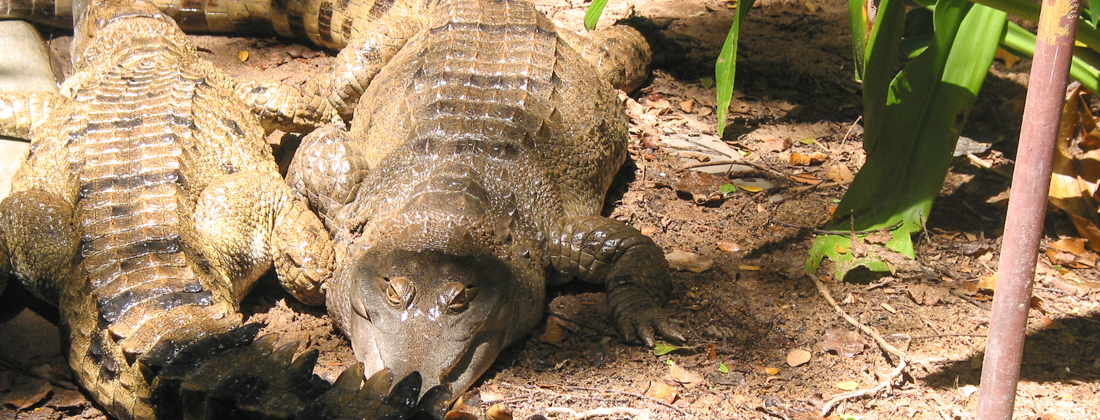
Wildlife Parks
Bandhavgarh National Park
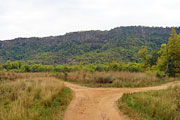 The impressive scenery at the Bandhavgarh National Park in Madhya Pradesh is marked by the fascinating ruins of a two thousand year old fortress. Bandhavgarh is a rugged, rocky landscape with flat grasslands in the valleys and tropical forests at higher altitudes. The park has the largest tiger population in India. With a bit of luck, one might spot the impressive wild cats in their natural habitat during a safari, especially when scanning the vast grazing lands that extend into the distance. Another option offered here is to roam the jungle on elephant back. Among the other species inhabiting the Bandhavgarh National Park are leopards, hyenas, wild dogs, axis deer, sambar deer, antelope, wild boar, monkeys and over 150 species of birds.
The impressive scenery at the Bandhavgarh National Park in Madhya Pradesh is marked by the fascinating ruins of a two thousand year old fortress. Bandhavgarh is a rugged, rocky landscape with flat grasslands in the valleys and tropical forests at higher altitudes. The park has the largest tiger population in India. With a bit of luck, one might spot the impressive wild cats in their natural habitat during a safari, especially when scanning the vast grazing lands that extend into the distance. Another option offered here is to roam the jungle on elephant back. Among the other species inhabiting the Bandhavgarh National Park are leopards, hyenas, wild dogs, axis deer, sambar deer, antelope, wild boar, monkeys and over 150 species of birds.
Bandipur National Park
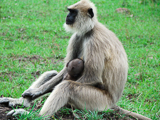 Located in the state of Karnataka, Bandipur National Park had become a protected area as early as 1898. It was officially declared a national park in 1941. Since 1973, Bandipur has been one of the most well-known tiger reserves in India. The park is bordered in the north by Nagarhole Wildlife Sanctuary and on the south by Mudumalai National Park. The wooded, hilly landscape is characterized by gentle slopes and wide plateaus. The park is home to a variety of wildlife species, such as tigers, leopards, elephants, wild dogs, Indian bison or gaur, birds of prey, and various deer species. A special wildlife experience is to take a jeep safari with experienced guides.
Located in the state of Karnataka, Bandipur National Park had become a protected area as early as 1898. It was officially declared a national park in 1941. Since 1973, Bandipur has been one of the most well-known tiger reserves in India. The park is bordered in the north by Nagarhole Wildlife Sanctuary and on the south by Mudumalai National Park. The wooded, hilly landscape is characterized by gentle slopes and wide plateaus. The park is home to a variety of wildlife species, such as tigers, leopards, elephants, wild dogs, Indian bison or gaur, birds of prey, and various deer species. A special wildlife experience is to take a jeep safari with experienced guides.
Corbett National Park
Scenic Corbett National Park stretches out in the Indian state of Uttarakhand across the Kumaon foothills and is one of the last wildlife sanctuaries in the Indian Himalayas. The area, stretching out over 520 km², is protected by a buffer zone of extensive deciduous and sal forests. It is only this border area that can be visited by tourists. The core area of 330 km² is not accessible to visitors. Corbett National Park is famous for its large population tigers, but seeing the elusive cats involves a bit of luck. Among the other animals in the park are elephants, crocodiles, jackals, wild boar and more than 500 different bird species.
Mudumalai National Park
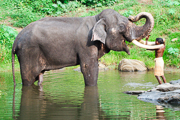 Set in a beautiful, forested landscape at an altitude of 1100m, the Mudumalai Wildlife Sanctuary in Tamil Nadu has one of the largest elephant herds in South India. The area is also inhabited by other wildlife such as Indian buffalo (gaurs), wild boar, langur, wild dogs, jackals, otters, crocodiles, leopards and tigers. Visitors can go on safari and – with a bit of luck – see the animals in their natural habitat. Another possibility is a trek with local guides. Mudumalai also has an elephant camp, where one often gets to see the bathing and feeding of the animals.
Set in a beautiful, forested landscape at an altitude of 1100m, the Mudumalai Wildlife Sanctuary in Tamil Nadu has one of the largest elephant herds in South India. The area is also inhabited by other wildlife such as Indian buffalo (gaurs), wild boar, langur, wild dogs, jackals, otters, crocodiles, leopards and tigers. Visitors can go on safari and – with a bit of luck – see the animals in their natural habitat. Another possibility is a trek with local guides. Mudumalai also has an elephant camp, where one often gets to see the bathing and feeding of the animals.
Kanha National Park
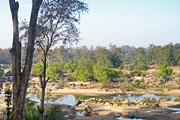 Kanha National Park is located in the state of Madhya Pradesh and covers nearly 2000 km². With its deciduous forests, grasslands, hills and rivers, the park is a home to hundreds of animal and bird species, including a small tiger population. The wide, grassy meadows in the river valleys sustain larger species of red deer. In the forests, teak, sal and other precious wood trees thrive, while black-faced langur monkeys swing from tree to tree in the foliage above.
Kanha National Park is located in the state of Madhya Pradesh and covers nearly 2000 km². With its deciduous forests, grasslands, hills and rivers, the park is a home to hundreds of animal and bird species, including a small tiger population. The wide, grassy meadows in the river valleys sustain larger species of red deer. In the forests, teak, sal and other precious wood trees thrive, while black-faced langur monkeys swing from tree to tree in the foliage above.
Keoladeo (or Bharatpur) Nationalpark
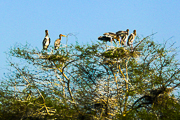 Keoladeo National Park in Rajasthan was formerly known as the Bharatpur Bird Sanctuary and was reserved for hunting by the royal family. Several species of herons have their habitat here, such as the Purple Heron, the Grey Heron and the Indian Pond Heron. Other bird species present include the painted stork, Eurasian spoonbill, white ibis and gray pelican From October to March, the area is home to 130 species of migratory birds that come from faraway places, such as Russia, to winter here. The park also forms a habitat for wild boar, mongoose, species of deer and antelope.
Keoladeo National Park in Rajasthan was formerly known as the Bharatpur Bird Sanctuary and was reserved for hunting by the royal family. Several species of herons have their habitat here, such as the Purple Heron, the Grey Heron and the Indian Pond Heron. Other bird species present include the painted stork, Eurasian spoonbill, white ibis and gray pelican From October to March, the area is home to 130 species of migratory birds that come from faraway places, such as Russia, to winter here. The park also forms a habitat for wild boar, mongoose, species of deer and antelope.
Periyar National Park
Kerala National Park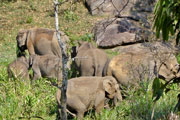 Periyar National Park – Located in Kerala, this park is one of the most well-known nature and wildlife reserves in South India. The 770 km² of this park form a habitat for more than 800 elephants and 35 tigers, among other animal species. Visitors have several options to choose from. Periyar Lake has a surface area of 26 km². One can take a boat trip out onto the lake and, with a little luck, observe elephants and a variety of other wild animals that come to the lake’s shore to drink. Also recommended is a morning hike with a competent, official guide from the area. The highlight is a full-day program that combines trekking with bamboo rafting and leads the visitor deep into the area with official guides. In this way, elephants can often be observed in their natural habitat.
Periyar National Park – Located in Kerala, this park is one of the most well-known nature and wildlife reserves in South India. The 770 km² of this park form a habitat for more than 800 elephants and 35 tigers, among other animal species. Visitors have several options to choose from. Periyar Lake has a surface area of 26 km². One can take a boat trip out onto the lake and, with a little luck, observe elephants and a variety of other wild animals that come to the lake’s shore to drink. Also recommended is a morning hike with a competent, official guide from the area. The highlight is a full-day program that combines trekking with bamboo rafting and leads the visitor deep into the area with official guides. In this way, elephants can often be observed in their natural habitat.
Ranthambore Wildlife Sanctuary
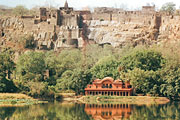 Located in the southeastern part of Rajasthan, this wildlife area, comprising 410 km², starts 10 kilometers beyond the small town of Sawai Madhopur. It stretches across rocky hills and an open valley with small ponds and fruit trees at the eastern foothills of the Aravalli and Vindhya Ranges. The Ranthambore National Park is one of the most appealing wildlife reserves in the world. It gets its special atmosphere from the ruins of the old fortress, rising in the center of the reserve. Interspersed along the old fortress wall are several semi-circular bastions. Stunningly beautiful vantage points and steep rock formations, with drops of up to 65 meters, dominate the landscape. The park is home to tigers, leopards, hyenas, jackals, jungle cats, marsh crocodiles, wild boars, bears, several deer species and a multitude of bird species. A safari in Ranthambore National Park is an unforgettable experience.
Located in the southeastern part of Rajasthan, this wildlife area, comprising 410 km², starts 10 kilometers beyond the small town of Sawai Madhopur. It stretches across rocky hills and an open valley with small ponds and fruit trees at the eastern foothills of the Aravalli and Vindhya Ranges. The Ranthambore National Park is one of the most appealing wildlife reserves in the world. It gets its special atmosphere from the ruins of the old fortress, rising in the center of the reserve. Interspersed along the old fortress wall are several semi-circular bastions. Stunningly beautiful vantage points and steep rock formations, with drops of up to 65 meters, dominate the landscape. The park is home to tigers, leopards, hyenas, jackals, jungle cats, marsh crocodiles, wild boars, bears, several deer species and a multitude of bird species. A safari in Ranthambore National Park is an unforgettable experience.
Wayanad
 The Wayanad Wildlife Sanctuary in the northeastern part of Kerala is an integral part of the Nilgiri Biosphere Reserve and is visited by few tourists. With its stunning landscapes, its quiet location and its moderate climate, this park, also known locally by the name Muthanga, is a paradise for nature lovers. On walks and jeep safaris, one can observe elephants, tigers, leopards, wild buffalos, deer and other wild animals in a pristine landscape. In the immediate vicinity of the park, at an altitude of 700-2100 m, there are areas of coffee, tea, cardamom, rubber and pineapple cultivation. The region also has an interesting range of adventure activities on offer, such as bamboo rafting, extensive bicycle tours and longer treks.
The Wayanad Wildlife Sanctuary in the northeastern part of Kerala is an integral part of the Nilgiri Biosphere Reserve and is visited by few tourists. With its stunning landscapes, its quiet location and its moderate climate, this park, also known locally by the name Muthanga, is a paradise for nature lovers. On walks and jeep safaris, one can observe elephants, tigers, leopards, wild buffalos, deer and other wild animals in a pristine landscape. In the immediate vicinity of the park, at an altitude of 700-2100 m, there are areas of coffee, tea, cardamom, rubber and pineapple cultivation. The region also has an interesting range of adventure activities on offer, such as bamboo rafting, extensive bicycle tours and longer treks.
